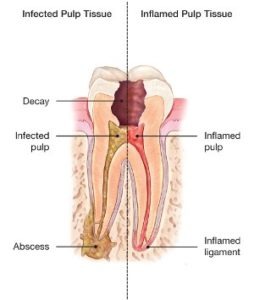
Root canals have developed quite a reputation since the dawn of modern dentistry, but we’re here to assure you that root canal treatment is now actually very common and far from the reputation it once held. There are many benefits of a root canal procedure for improving your oral health and prolonging the life of your teeth. Without root canals, many adult teeth would have to be removed! To avoid these most extreme circumstances, it’s important to visit your dentist regularly.
Has it been a while since the last time you went to the dentist, but you suspect you might require dental treatment? Here are some of the most telling signs you might need a root canal — along with an explanation of root canal treatment and how it works.
What Exactly Is a Root Canal?
You might have a good idea about why root canal treatment is important, but have you been wondering what exactly is a root canal? The American Association of Endodontists explains root canal treatments this way:
“Root canal treatment is designed to eliminate bacteria from the infected root canal, prevent reinfection of the tooth and save the natural tooth. When one undergoes a root canal, the inflamed or infected pulp is removed and the inside of the tooth is carefully cleaned and disinfected, then filled and sealed.”

Diagram of an infected and abscessed tooth root from the AAE
For readers who aren’t endodontists (dentists who specialize in treating the ends/roots of the teeth), we can break down this explanation a little further. Inside the innermost part of every tooth is a soft tissue known as pulp, or pulp tissue. This tissue is made up of blood vessels, nerve endings and connective tissue that help a tooth and its root grow when developing. Healthy adult teeth are able to survive even without this pulp with the help of other healthy tissues surrounding them. However, when this inner pulp becomes irritated or infected, it must be removed in order to stop dental pain and prevent tooth loss.
Root canal procedures, then, are treatments where a trained dentist or endodontist will carefully remove the affected pulp from inside the tooth. Afterward, the remaining canal is cleaned out and sealed with a dental sealant. More on this process near the end of this blog post!
Look for These Signs
So, how can you know if you need a root canal? While only a dentist can confirm if your tooth’s pulp is infected or inflamed and will require root canal treatment, there are some key telltale signs and symptoms that you can look for on your own before your appointment.
These root canal symptoms include:
- Temperature Sensitivity — If your tooth is sensitive to both cold and hot beverages/foods, this could be a sign that the nerve endings and blood vessels in your tooth pulp are affected. You might feel either a sharp pain or a persistent dull ache that sticks around for a while after drinking or eating.
- Sensitivity to Touch — Pain or sensitivity caused by pressure from touching the tooth or while eating/biting can be a sign of nerve damage or tooth decay. As material builds up in the root from infection and decay, this can cause the tooth to become particularly sensitive to pressure.
- Constant Pain — Similar but different to touch temperature sensitivity, feeling constant or persistent pain in a tooth, jaw, face or surrounding teeth is another major symptom. This could also indicate gum disease, a cavity, an infection in an impacted tooth and other dental conditions. Always consult your dentist immediately when you experience any form of tooth pain.
- Swollen Gums — In addition to being a sign of gum disease, swollen gums could be caused by problems with a tooth’s root, especially if the swelling is concentrated near a single tooth that is causing pain. The swelling could be caused by an infected or dead tooth pulp, and it could also include an abscess containing fluid known as pus.
- Cracked or Chipped Tooth — Cracks or chips in a tooth can create an opening for bacteria to find its way into the inside of your tooth, causing inflammation and infection over time. Injured teeth that don’t crack or chip can also be at risk due to damage to the inner nerves.
- Loose Tooth — If your adult tooth feels loose and wiggly, the inside of the tooth could be infected, and the nerve endings could be dead. This causes the supporting bone to become soft and the tooth itself to become mobile. However, a loose tooth is only a potential sign of needing a root canal if only one tooth is loose. More than one tooth likely indicates other serious dental conditions.
- Dark Colored Tooth — No, we’re not talking about yellow teeth. When it comes to tooth root concerns, dark grayish-black coloration seen from the external front of a tooth can be a major sign of internal root tissue damage and infection.
You should contact your dentist immediately if you are experiencing any of these symptoms. And, once again, the type of dental treatment you will need will depend on the evaluation of a skilled dentist. If a dentist does determine that one of your tooth roots needs to be removed, he or she will recommend a root canal procedure with themselves, if they are properly trained, or with an endodontist who specializes in root canal treatment.
A Quick Look at Root Canal Treatment
While we previously covered what happens during a root canal procedure in our blog post, “What to Expect with a Root Canal,” here is another quick overview of root canal treatment:
Beginning of the Treatment
Prior to the procedure, your dentist or endodontist will take X-rays to assess the state of your root canal damage. Then, you will be provided a local anesthetic to numb the affected area of the mouth during the procedure. A rubber-like sheet known as a dental dam will then be placed in your mouth to keep the affected tooth protected. Finally, the dentist will make a small opening at the top of the tooth to reach the inner pulp, which is then removed.
Clearing Out and Disinfecting
Next, the remaining material in the pulp chamber will be fully cleaned out, possibly followed by enlarging reshaping of the canal. To completely clear out and prevent further infection, your dentist may also apply medication into the root canal and pulp chamber. Some root canals may need to be left open for a few days to properly dry out, with a temporary filling placed on top in the meantime.
Filling the Root Canal
Once the inside of the tooth is clean and dry, your dentist will fill the empty space with a sealer paste and rubber compound, then a dental filling on top to keep the root canal protected and secured.
Restoration and Sealing
At last, the procedure is almost over. The last step is restoration for the top of your affected tooth. Generally, a dental crown will be secured on top of the original tooth to provide a natural look, to protect the sealant and rest of the remaining tooth, and to return your tooth’s proper functionality. Crown materials include porcelain, porcelain fused to metal, or gold.
After Care
You may experience a few days of mild sensitivity after a root canal, but afterward you should be able to return to a feeling of normal when eating, drinking or speaking. If you experience any pain that is more serious or lasts longer than a few days, contact your dentist immediately.
Root Canal Dentist: Bucktown, Logan Square, Wicker Park, Humboldt Park
If you are experiencing symptoms that indicate a root canal may be necessary, don’t wait any longer to see a dentist! NK Family Dental has been the choice of Bucktown and Logan Square for years due to our high standards of compassionate care and quality dental treatment. We are a local Chicago dentist office, serving the neighborhoods of not only Bucktown and Logan Square, but also Wicker Park and Humboldt Park. Our doctors include our owner and General Dentist Dr. Nilofer Khan, our periodontist Dr. Amir Danesh, and our endodontist Dr. Sabek.
Find relief for your dental discomfort today by booking an appointment with NK Family Dental on ZocDoc, or by contacting us directly!
